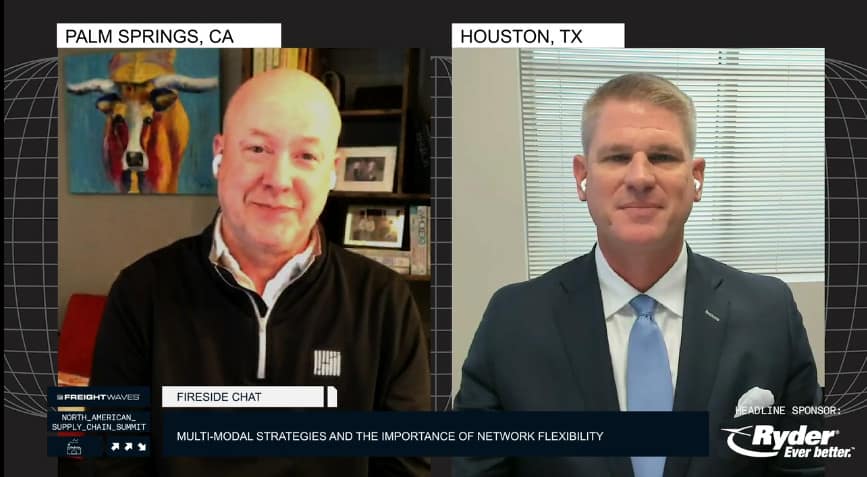Retailers that can pivot between online sales and foot traffic smoothly and successfully will be the ones able to take full advantage of the rapid rise in e-commerce, according to Shawn Stewart, president and managing director for North America for third-party logistics company CEVA Logistics (OTCMKTS: CVLGF).
E-commerce “has been a fantastic option for [retailers] to stay open and stay profitable,” Stewart said Tuesday during the FreightWaves North American Supply Chain Summit. “Anything they can do to build out their e-comm solutions will drive longevity.”
Although many of CEVA’s large retail customers have had “a very tough year” because of the COVID-19 pandemic, what’s been interesting is how companies have pivoted to accommodate increased online shopping, Stewart said. Storefronts have turned into mini distribution centers where sales associates are not only working the floor but are also fulfilling e-commerce orders, he said.
Some of CEVA’s customers have supply chains with the target to fulfill store inventory versus the inventory of an e-commerce distribution center, and that’s because those retailers don’t have the ability to scale to the size of a distribution center, according to Stewart.
“Most of those clients are moving heavily now into building out or outsourcing the build-out of large e-comm facilities to transition them to the new normal after this pandemic,” he noted.
As they scale up, customers will have to grapple with two issues, according to Stewart. One is dealing with limited capacity among the parcel carriers. While a parcel network is able to accommodate mass orders picked up from a distribution center, it doesn’t have enough trucking capacity or pickup orders from individual stores in different locations.
Another issue is being able to fulfill orders in a timely manner, whether that means enabling a consumer to get an order in time or getting an order dropped off to a parcel carrier in a timely fashion, Stewart said.
“That’s what we’re really seeing today, and many of us are working to try to figure out how to help them with those sweeps and/or other alternatives that may be outside of the parcel network because there’s just not enough capacity,” Stewart said.
As other companies did, CEVA had to adjust its operations as the coronavirus pandemic started in March in North America and continues to the present day. After ensuring the safety of their employees, CEVA needed to adjust to a work environment in which more than half of the company’s employees work remotely.
Some of the challenges that CEVA faced included being part of a logistics industry that is becoming increasingly paperless but hadn’t yet made the full jump, Stewart said.
“How do we take more paper out of the daily operations and only keep those vital operators within the branches” while everyone else works remotely using digital tools? he asked.
Another challenge was needing to come up with a plan C or D since unlike a natural disaster, which is self-contained, the COVID-19 pandemic took place all over the world. As a result, the historical response of shifting operations to another region of the word didn’t apply in 2020, Stewart said.
To address this challenge and still meet customers’ needs, CEVA invested in securing airfreight capacity for the immediate term and further out, whether that meant securing access to chartered flights or working with the traditional passenger airliners to pull the seats from their aircrafts and become converted freighters, Stewart said. And since airfreight capacity was looser for certain origin-destination pairs, CEVA would have to rely on its ground network to reposition cargo within the U.S., he said.
CEVA also told customers that they could use the ocean vessels to ship imports to North America, which is an option some customers are still using despite premium costs for some services, Stewart said.
If there is any silver lining from the COVID-19 pandemic, it was that it enabled a more altruistic supply chain, according to Stewart.
“I would say that there’s always a positive out of a negative. And what I would say is that the world holistically became more humble,” Stewart said. “We all were fighting a major pandemic, which was scary for all of us. So there was a much more humanistic side of our relationships between the customers, the carriers, the third-party logistics partners … to where we needed each other.”
CEVA is a subsidiary of global shipping carrier CMA CGM.
Subscribe to FreightWaves’ e-newsletters and get the latest insights on freight right in your inbox.
Click here for more FreightWaves articles by Joanna Marsh.
Related articles:
CMA CGM’s third-quarter profits jump 1,160%
Borderlands: Border trucking capacity remains tight; Schneider Electric expanding in Tijuana
CEVA Logistics widens stance in Africa
Logistics providers weigh workforce reductions amid drop in trade
Airlines, governments and 3PLs get creative with emergency airlifts











